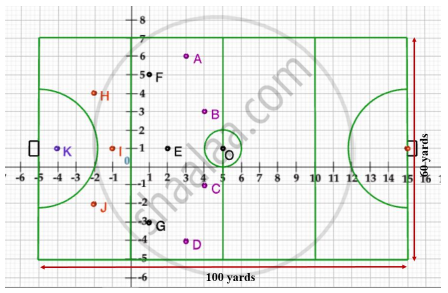Advertisements
Advertisements
प्रश्न
Find distance between points O(0, 0) and B(– 5, 12)
उत्तर
Let O(x1, y1) = O(0, 0) and B(x2, y2) = B(– 5, 12)
∴ x1 = 0, y1 = 0, x2 = – 5, y2 = 12
By distance formula,
d(O, B) = `sqrt((x_2 - x_1)^2 + (y_2 - y_1)^2`
= `sqrt((-5 - 0)^2 + (12 - 0)^2`
= `sqrt((-5)^2 + 12^2`
= `sqrt(25 + 144)`
= `sqrt(169)`
∴ d(O, B) = 13 units
∴ The distance between the points O and B is 13 units.
APPEARS IN
संबंधित प्रश्न
The x-coordinate of a point P is twice its y-coordinate. If P is equidistant from Q(2, –5) and R(–3, 6), find the coordinates of P.
If P and Q are two points whose coordinates are (at2 ,2at) and (a/t2 , 2a/t) respectively and S is the point (a, 0). Show that `\frac{1}{SP}+\frac{1}{SQ}` is independent of t.
Find the coordinates of the circumcentre of the triangle whose vertices are (8, 6), (8, – 2) and (2, – 2). Also, find its circum radius
Show that the quadrilateral whose vertices are (2, −1), (3, 4) (−2, 3) and (−3,−2) is a rhombus.
Find all possible values of x for which the distance between the points
A(x,-1) and B(5,3) is 5 units.
If the point A(x,2) is equidistant form the points B(8,-2) and C(2,-2) , find the value of x. Also, find the value of x . Also, find the length of AB.
If P (x , y ) is equidistant from the points A (7,1) and B (3,5) find the relation between x and y
Find the value of y for which the distance between the points A (3, −1) and B (11, y) is 10 units.
Find the value of a if the distance between the points (5 , a) and (1 , 5) is 5 units .
Find the distance between P and Q if P lies on the y - axis and has an ordinate 5 while Q lies on the x - axis and has an abscissa 12 .
Find the point on the x-axis equidistant from the points (5,4) and (-2,3).
Find the coordinate of O , the centre of a circle passing through A (8 , 12) , B (11 , 3), and C (0 , 14). Also , find its radius.
Find the coordinate of O , the centre of a circle passing through P (3 , 0), Q (2 , `sqrt 5`) and R (`-2 sqrt 2` , -1). Also find its radius.
The distances of point P (x, y) from the points A (1, - 3) and B (- 2, 2) are in the ratio 2: 3.
Show that: 5x2 + 5y2 - 34x + 70y + 58 = 0.
The distance between point P(2, 2) and Q(5, x) is 5 cm, then the value of x ______
The distance between the points (0, 5) and (–5, 0) is ______.
Case Study -2
A hockey field is the playing surface for the game of hockey. Historically, the game was played on natural turf (grass) but nowadays it is predominantly played on an artificial turf.
It is rectangular in shape - 100 yards by 60 yards. Goals consist of two upright posts placed equidistant from the centre of the backline, joined at the top by a horizontal crossbar. The inner edges of the posts must be 3.66 metres (4 yards) apart, and the lower edge of the crossbar must be 2.14 metres (7 feet) above the ground.
Each team plays with 11 players on the field during the game including the goalie. Positions you might play include -
- Forward: As shown by players A, B, C and D.
- Midfielders: As shown by players E, F and G.
- Fullbacks: As shown by players H, I and J.
- Goalie: As shown by player K.
Using the picture of a hockey field below, answer the questions that follow:

The coordinates of the centroid of ΔEHJ are ______.
∆ABC with vertices A(–2, 0), B(2, 0) and C(0, 2) is similar to ∆DEF with vertices D(–4, 0), E(4, 0) and F(0, 4).
Find a point which is equidistant from the points A(–5, 4) and B(–1, 6)? How many such points are there?
The distance between the points (0, 5) and (–3, 1) is ______.
